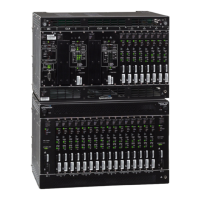1
097-55501-01 Issue 6 – June 2003 115
2
5
3
Operational Verification & Configuration
5. If it is convenient this is a good point to check that the inter-shelf
links are functioning properly. To do this requires that the master
shelf and the expansion shelf are powered and there is at least one
clock card installed on the master shelf.
a. Insert an EC card (090-55545-01) into the EC1 (leftmost) slot on
the front of the expansion shelf. If power has been supplied to
both terminals on this shelf, there should be green Shelf Power
A and B LEDs showing on this card. To test the links there must
be at least one clock card in the master shelf that is in a mode
where it is providing timing output in either "Tracking" or "Fast
Track" mode.
Given that above conditions are met, both link LEDs should show
green. If so, this indicates that both link 1 and link 2 connections
are properly functioning. If more detailed checking is desired,
disconnect either of the link cables. The response should be seen on
the corresponding link LED on the EC card.
b. Assuming there is a second EC card for this expansion shelf, in-
sert it into the EC2 slot. It should show Power and Link LEDs
identically to the EC card in the EC1 slot. It should always be the
case that if a link shows green in one EC card, it should also
show green on the other EC card. This is because the EC cards
are truly redundant – both EC cards are independently connect-
ed to and evaluating both links.
The remaining link check steps are not critical since basic link
operation is now established, but they can be performed to establish
further confidence that all potential scenarios are working correctly.
a. If the master shelf is not currently in service, confirm that the
links remain okay when only CLK1 or only CLK2 is available
from the master shelf. For example, to check CLK1 only, simply
remove CLK2. In this configuration, obviously only CLK1 timing
is available. It should be provided on both links, so both EC
cards should still show both links as OK. Note that an alarm is
expected in this case on the EC card that is not receiving it's pre-
ferred clock. For the example of only CLK1 providing timing, EC2
should show an alarm (but links OK) as an indication that it is
not getting its link from CLK2.
Perform a similar test where only CLK2 is installed. Again, the
expectation is that all links should remain green. An alarm is
expected on EC1 since it can't get its link from CLK1. Keep in
mind that master shelf clock cards do not provide timing while
powering up or when in the Warmup state, so a clock card in
such a mode does not provide signals that can validate any
link.

